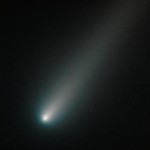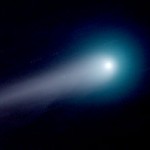Date Time(UT) RA Dec Az El Mag Dist(AU)
2013-May-30 00:00 * 13 43 52.20 -28 33 56.2 112.3 -29.8 11.21 0.04085
2013-May-30 02:00 * 13 46 41.34 -28 16 36.7 118.4 -4.7 11.18 0.04069
2013-May-30 04:00 * 13 49 26.76 -27 58 53.8 130.2 18.3 11.16 0.04054
2013-May-30 06:00 A 13 52 09.08 -27 40 36.2 151.4 36.2 11.14 0.04040
2013-May-30 08:00 13 54 49.78 -27 21 36.2 184.3 42.6 11.12 0.04027
2013-May-30 10:00 m 13 57 30.80 -27 01 52.3 215.4 33.2 11.10 0.04016
2013-May-30 12:00 m 14 00 14.01 -26 41 29.3 234.5 13.6 11.08 0.04006
2013-May-30 14:00 m 14 03 00.70 -26 20 37.2 245.4 -10.2 11.06 0.03998
2013-May-30 16:00 *m 14 05 51.26 -25 59 28.2 251.6 -35.9 11.04 0.03989
2013-May-30 18:00 *m 14 08 45.07 -25 38 14.0 252.2 -62.2 11.02 0.03981
2013-May-30 20:00 *m 14 11 40.61 -25 17 03.0 180.9 -84.4 11.00 0.03973
2013-May-30 22:00 * 14 14 35.91 -24 55 57.7 106.2 -62.5 10.98 0.03965
2013-May-31 00:00 * 14 17 28.96 -24 34 55.0 106.6 -35.9 10.96 0.03956
2013-May-31 02:00 * 14 20 18.30 -24 13 47.1 112.4 -9.7 10.94 0.03948
2013-May-31 04:00 * 14 23 03.30 -23 52 23.2 122.8 14.9 10.92 0.03940
2013-May-31 06:00 A 14 25 44.36 -23 30 33.2 141.7 35.8 10.90 0.03933
<strong>2013-May-31 08:00 14 28 22.79 -23 08 10.0 174.9 46.8 10.89 0.03928</strong>
<strong>2013-May-31 10:00 14 31 00.46 -22 45 11.5 211.6 40.5 10.87 0.03924</strong>
2013-May-31 12:00 m 14 33 39.26 -22 21 41.4 234.6 21.6 10.86 0.03922
2013-May-31 14:00 m 14 36 20.68 -21 57 48.0 247.4 -2.4 10.84 0.03921
2013-May-31 16:00 *m 14 39 05.32 -21 33 42.1 255.5 -28.6 10.83 0.03921
2013-May-31 18:00 *m 14 41 52.80 -21 09 34.6 261.1 -55.6 10.81 0.03921
2013-May-31 20:00 *m 14 44 41.82 -20 45 33.3 260.5 -83.0 10.80 0.03921
2013-May-31 22:00 *m 14 47 30.51 -20 21 41.7 95.4 -69.3 10.78 0.03921
2013-Jun-01 00:00 * 14 50 16.87 -19 57 58.3 99.5 -41.8 10.77 0.03921
2013-Jun-01 02:00 * 14 52 59.31 -19 34 17.3 105.9 -14.8 10.75 0.03920
2013-Jun-01 04:00 * 14 55 37.04 -19 10 30.4 115.3 11.2 10.74 0.03920
2013-Jun-01 06:00 A 14 58 10.22 -18 46 29.3 131.8 34.7 10.73 0.03921
<strong>2013-Jun-01 08:00 15 00 39.97 -18 22 08.0 163.7 50.2 10.72 0.03924</strong>
<strong>2013-Jun-01 10:00 15 03 08.03 -17 57 24.4 206.9 47.9 10.71 0.03928</strong>
2013-Jun-01 12:00 m 15 05 36.32 -17 32 20.9 234.7 29.7 10.70 0.03934
2013-Jun-01 14:00 m 15 08 06.41 -17 07 04.2 249.5 5.3 10.69 0.03941
2013-Jun-01 16:00 *m 15 10 39.11 -16 41 42.7 259.1 -21.1 10.69 0.03949
2013-Jun-01 18:00 *m 15 13 14.27 -16 16 25.3 267.5 -48.5 10.68 0.03957
2013-Jun-01 20:00 *m 15 15 50.83 -15 51 18.8 283.9 -75.9 10.67 0.03966
2013-Jun-01 22:00 *m 15 18 27.08 -15 26 26.5 75.8 -74.8 10.67 0.03974


